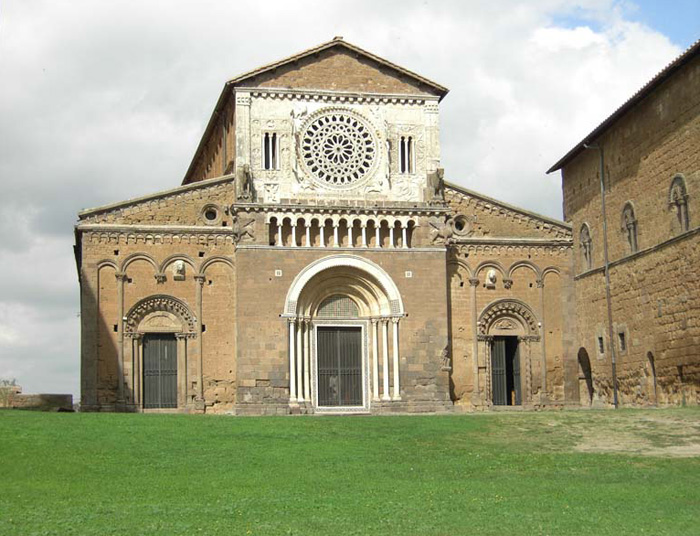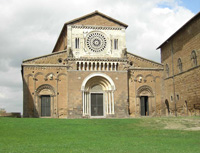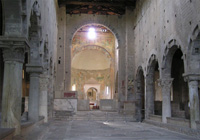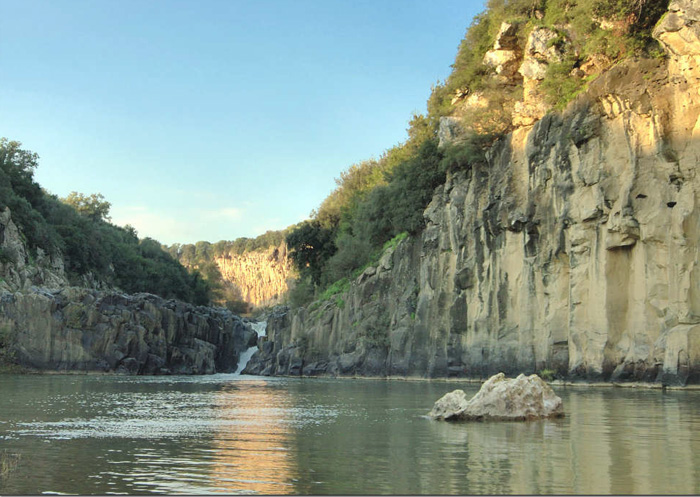|
|
| Tuscania , Chiesa di San Pietro | |
Tuscania and Vulci |
| Vulci, Tarquinia and Tuscania represent the emblems of Etruscan civilization. Tuscania The ancient city Tuscania was a prosperous Etruscan centre in the 3rd century bc, and Etruscan tombs have been found nearby. A significant stability of human settlements, dates to the Etruscan period, as witnessed by the numerous necropolises in the area. The most famous, on the slope opposite the hill, is the one of the Madonna dell'Olivo with the tombs of the Curunas family (containing remarkable sarcophaguses found in 1967-1970), of the Sarcophagus and of the Queen, characterised by a series of labyrinths with about thirty tunnels. Of the other necropolises, we should mention Pian di Mola, Peschiera (tomb of the Dice) and Carcarello (sepulchre of the Vipinana family). After the Etruscan and Roman periods, which according to the historians were characterised by a peaceful continuity of economic and social life unlikely to be found elsewhere, the hill of San Pietro was first depopulated as a result of the barbarian invasions and then underwent new urbanisation, starting in the eighth century, spreading as far as the nearby hill of Rivellino. The construction of the church of San Pietro dates to this early medieval period. In 1348-49 a bubonic plague, the Black Death, almost halved the population of Europe. In Tuscania its impact was so heavy that the oldest part of the town where the main medieval churches, the Basilica of Santa Maria Maggiore and the Basilica of San Pietro were located, was abandoned. Until a disastrous earthquake in 1971, the town contained many relics and treasures of the Etruscan, Roman, and medieval periods. The quake severely damaged the town's two magnificent Romanesque-Lombard churches, San Pietro (8th and 12th centuries), the rose window and parts of the apse and adjacent towers of which collapsed, and Santa Maria Maggiore (7th and 12th centuries), which lost the top of its stone bell tower. Other churches and buildings in the town also sustained heavy damage. By the late 20th century, however, most buildings had been either restored or replaced. |
||
| Outside the walls, there is the wondrous sight of San Pietro and Santa Maria Maggiore, two ancient basilicas placed on solitary hills, just a few metres one from the other. San Pietro was founded at the beginning of the VIII century, it is the most important church in Tuscania and one of the first, great architectural accomplishments for Christianity in the Lombard-Romanesque style, one of the very first truly Italian churches. The church is facing east, on the hillside which was an acropolis for ancient Tuscania. It is not the result of a single project and a single phase of construction, rather it is the product of more than one intervention, expansion and decorative contribution. It is an architectonic work of sacred and social art, carried out by the architect, by the craftsmen and by the city itself. In the nearby basilica of Santa Maria Maggiore, the oldest in the town, we find the same Romanesque style with gothic elements evident in the picturesque portal. The interior hosts an exquisite ambo, a baptismal font and numerous pictorial decorations, including the Final Judgement. The important Abbazia di San Giusto, in the countryside near the town, is of the same style and from the same period. This abbey is completely restored and open to visitors. In the Medieval historical center the beautiful Roman Basilica of San Pietro stands on the old Etruscan acropolis. The basilica, one of the most magnificent monuments in the Viterbo area, probably dates to the eighth century. It has a remarkable thirteenth-century facade with three portals; the central Cosmati-style portal is surmounted by a gallery of small arches, between two winged animals, and by an elegant rose window incorporated in a panel decorated with the symbols of the Evangelists and flanked by two double lancet windows decorated with fanciful bas-reliefs of the Umbrian school. The interior has massive 11th century columns with beautiful capitals and decorative pavings. The precious twelfth-thirteenth-century frescoes of the Roman school, reflecting Byzantine influence, which decorate the apse, were seriously damaged in the earthquake of 1971. From the right-hand aisle, a staircase leads to the magnificent eleventh-century crypt with cross-vaults supported by 28 marble columns, originating from Roman buildings and decorated with archaic capitals, several of which are Corinthian of the fourth-fifth century. |
||
The Romanesque Chiesa di Santa Maria Maggiore was built during the same period as the church of San Pietro. The facade, preceded by a massive Romanesque tower, has three finely decorated portals. The central one, in white marble, is flanked by two spiral fluted columns: the ornate jambs are sculpted with St. Peter and St. Paul, and depicted in the lunette are the Madonna and Child with the mystic Lamb and the scene of the sacrifice of Abraham. The interior was rebuilt with fragments from the 8th, 9th, and 12th centuries.
|
||
Nostalghia, Andrej Tarkovsky
|
||
| The crypt of San Pietro is perhaps the only setting in which Tarkovsky could have placed "his" Madonna del Parto. The north-south axis of the transept windows, the dark recesses of thickly columned space, the window behind the Madonna, through which the birds exit the crypt, the potential within this arched matrix for the creation of framing conditions similar to those of Piero's original fresco—all of these elements create a spatial dimension which he manipulates in order to "cinematize" the fresco.[1]
|
||
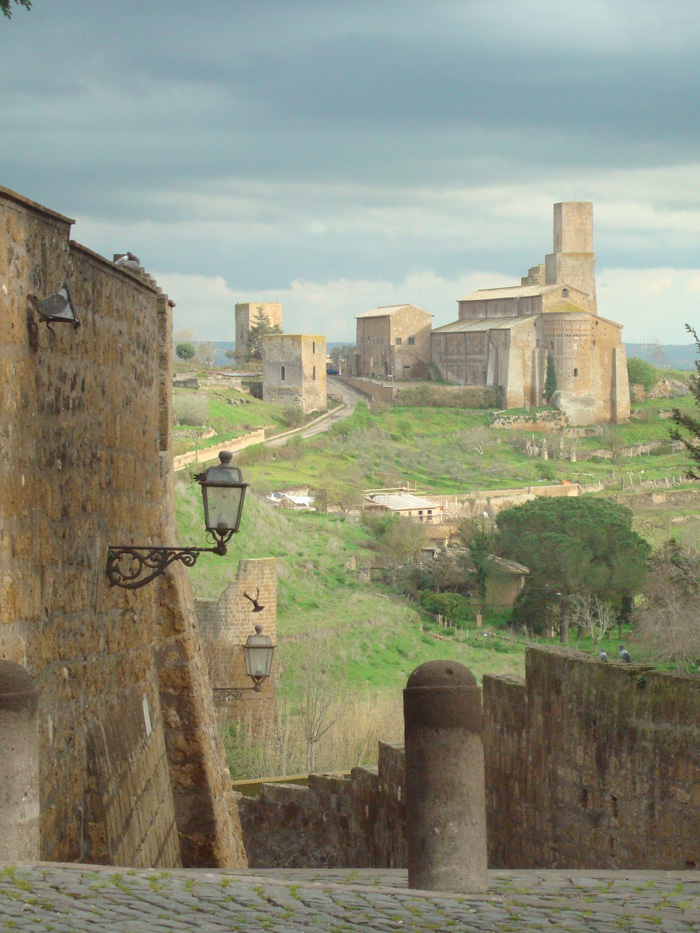 |
|
Tuscania, view on the the old Etruscan acropolis, and the Chiesa di San Pietro |
|
| Vulci |
||
The ruins of the city of Velch (Roman Vulci) lies between the villages of Canino and Montalto di Castro.
|
||
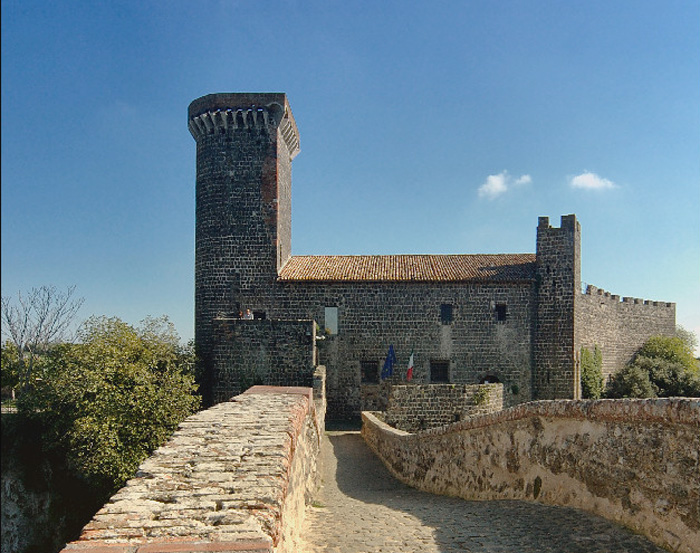 |
||
Vulci, Castello della Badia |
||
Canino is located in the Viterbo Maremma area bordering Tuscany. At the turn of the nineteenth century, Lucien Bonaparte stayed here and Pope Pius VII granted him the title of Prince of Canino. The collegiate church of Santi Apostoli Giovanni e Andrea, dating to the late eighteenth century, is the site of the Bonaparte Chapel containing the funerary monuments of Charles Bonaparte (father of Napoleon and Lucien), Christine Boyer (Lucien's first wife), Joseph Bonaparte (Lucien's san who died at the age of 14 months) and Lucien Bonaparte himself, portrayed near his wife on his deathbed. |
||
| The itinerary combines stunning gorge scenery and fascinating archaeological discoveries. A Roman road winds through the ruined temples and market place of Etruscan Vulci. Then on through holm oaks and wild olive trees to the stunning waterfall at Lake Pellicone, look out for kingfisher at the water's edge. [read more] |
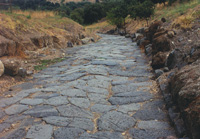 Vulci, strada Etrusca |
|
| Tuscania Nature Reserve | The Tuscania Nature Reserve, established in 1997, covers 1901 ha. Itineraries | Tuscania | From Canino to Tarquinia | From Tarquinia to Barbarano Romano | From Barbarano Romano to Capranica | From Sutri to Velo |
||
|
||
Tomb of the Augurs, nude wrestlers on the side walls, Monterozzi necropolis, Tarquinia |
||
Enlarge map Tuscania |
||
[1] James Macgillivray, Andrei Tarkovsky's Madonna del Parto.
|
||
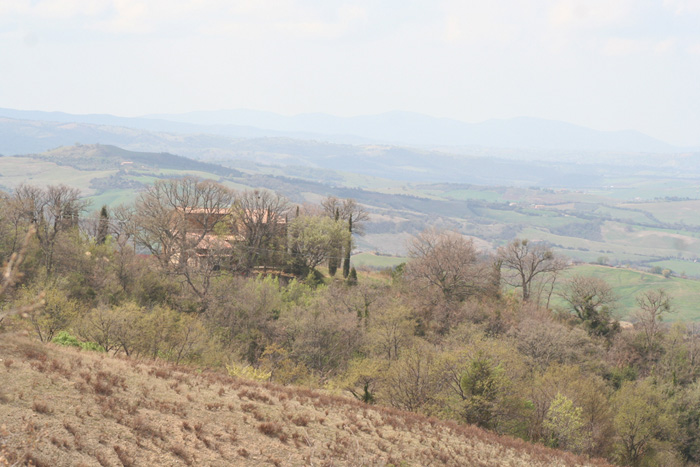 |
||
Podere Santa Pia, April. Situated in a lovely position in the Tuscan hills, Podere Santa Pia
overlooks the alluring Maremma countryside and further on to the sea.
|
||

